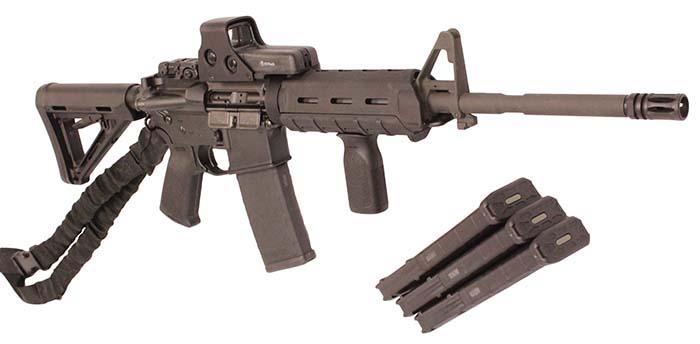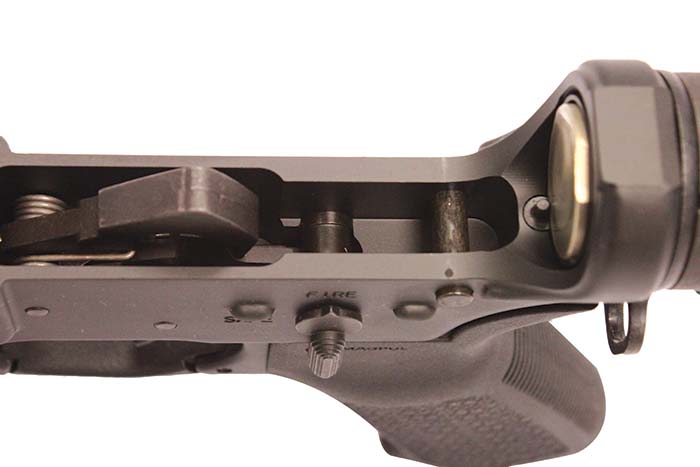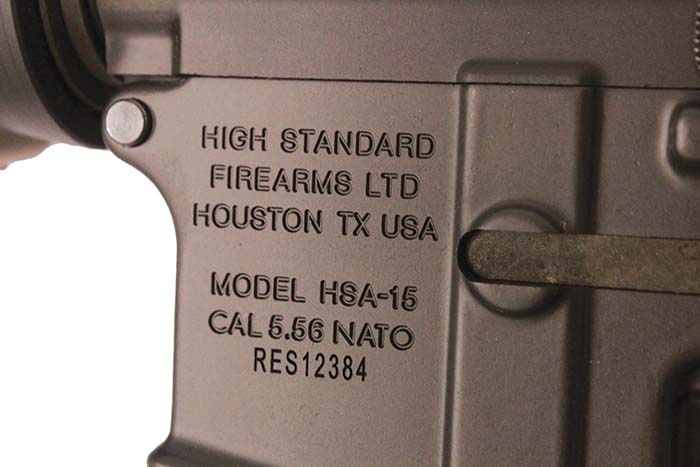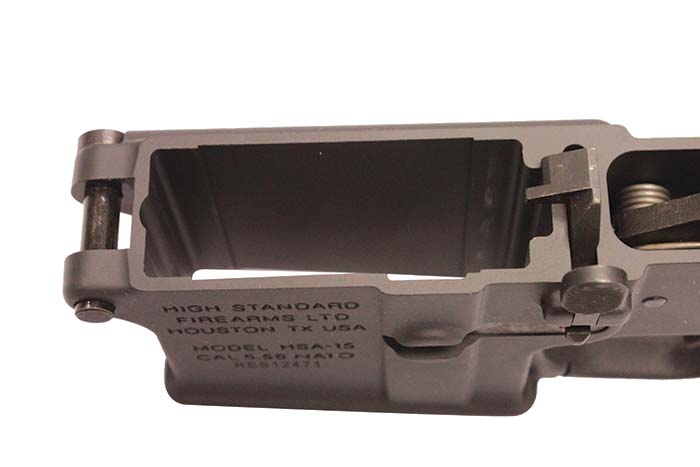The HSA-15 kit includes an Eotech electronic sight, Magpul backup rear sight, four P-mags and a single point sling. The rifle is trimmed in Magpul MOE furniture, with a VFG on the forearm. You just supply the ammo.
By David Lake
High Standard used to refer only to your .22 caliber target pistol. That was their market share when they started making small arms in the 1930s. Since those early days, High Standard has acquired the Interarms brand; originally a global arms trader. Also, High Standard now owns the AMT label; originally known for their all-stainless line of handguns. High Standard has not been out in front, blazing trails in the gun market, but has maintained a steady presence of quality firearms. High Standard still offers a few of the AMT pistols in limited production numbers. They offer some Kalashnikov variants as well and to round out the menu options High Standard brings us a complete and comprehensive lineup of AR-15 rifles.
In order to appreciate High Standard’s reputation, one must consider the company’s history. Depending on age, some will recall that for a time High Standard made the best target pistol in America (and arguable still does). Some will recall that High Standard enjoyed marked success during WWII in the hands of the OSS and the allied resistance fighters. That service model, the HDM, was an integrally suppressed version of the successful target pistol. The HDM has enjoyed continued, albeit rare, use over the past 6 decades by U.S. and British special forces. It has also been suggested, and can neither be confirmed nor denied, that the CIA placed Hi Standard pistols in the pilot survival packs aboard the U2 spy planes.
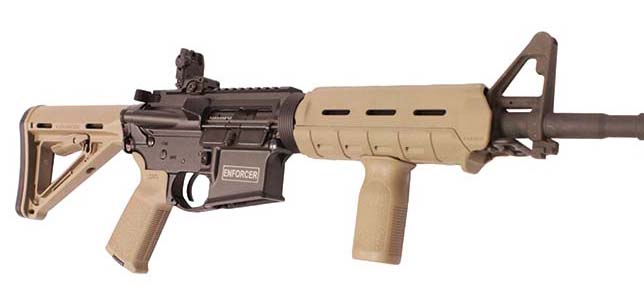
So we may proceed in agreement that High Standard is capable of manufacturing quality military-grade small arms. History speaks positively to this effect as there is nothing like battlefield experience to separate the amateurs from the professionals. High Standard’s line of AR based rifles all bear the model designation “HSA-15”. The 16-inch service carbine seems the most relevant to today’s common application, so we requested a few 16-inch carbines from High Standard.
Today, the AR-15 is likely the most popular thing going. Almost every major brand has added some form of the AR to their product lineup.
One could only guess at the scale of the AR-15 “specific” market that comprises all the accessories and upgrades made for the AR and the companies that make nothing but AR-15 rifles. There are printed magazines, web forums, online and shooting clubs, and even marketing and consulting firms that only treat the AR-15 and its kind. It’s an enormous part of our economy. At this point it is almost expected that every brand worth its salt has an AR-15 to throw at the consumer. For an individual company, the most difficult question to answer is, “how to make our AR-15 different?”
The draw to the AR is that it is a modular system. The AR requires no accurizing or special treatment to make it work well. It’s the plug-and-play “Lego” in the world of small arms. The gun can be prescribed as an economical entry model, or a professional’s tool built up to superfluous standards. If you’ve got $599, there’s an AR that will fit your budget. If you have $2,879, there’s an exceptional AR-15 to fill your bill. If you need to exchange accuracy for enhanced reliability, or vise-versa, or any “application specific” requirement, the AR can be bought, or at least built to suit. Therein lies the rub for manufacturers offering a built and boxed rifle. The consumer needs to “want” the gun that comes in the box but there are so many configurations and possibilities to building an AR-15. In attempting to satisfy all tasks and tastes, High Standard offers no less than 46 variations of the AR. They are differentiated by barrel lengths, weights and twist rates, stock and grip configurations, direct impingement or mechanical piston operating systems, and other “kit” or accessory items. They even span the color palette to suit an individual’s aesthetic. And then all of those possibilities can be had in your choice of caliber – as long as it’s .556 NATO or .300 Blackout.
High Standard supplied Small Arms Review with a representative sampling of 3 popular HSA-15 models: The Enforcer, Crusader, and a complete HAS-15 Kit, which included an Eotech, sling, and four P-mags. The kit rifle came in full MOE attire, complete with forward vertical grip and backup rear sight. These 3 models are all very similar with the only obvious difference was that the Enforcer included some accessories that the Crusader did not; Magpul MOE pistol grip, VFH and rear BUIS. Both rifles included a Magpul MOE buttstock and forearm assembly. At closer inspection we found one important difference. The Crusader was outfitted with a 1-7/inch twist barrel. The Enforcer wears a 1-9/inch twist barrel. This seemingly small difference places these rifles in distinct categories for intended application. A 1-9” twist barrel is ideally suited to fire lighter bullets from 40 up to 55 grains. The 1-7” twist rate asks for heavier bullets of 62 grains and heavier. The Enforcer should return better performance with lighter bullets with either the 40 and 45 grain frangible ammo used by law enforcement for training or the common 55 grain ball ammo used at the range by the typical consumer. The Crusader’s 1-7” suggest that it will require more specialized ammunition; like the M855 penetrator or M856 tracer ammunition. The 1-7” twist rate will even handle up to 75 grain special purpose bullets for hunting medium game.
The finish of the exemplar guns was excellent. They presented without nicks or dings of any sort. The anodizing color and sheen was consistent on all surfaces. The Parkerized surface on the chrome-moly barrels was a smooth matte gray free of any blemish or burnish. We could spot no damage at all: none from assembly and none from shipping and handling. Firearms from many brands today are delivered in a less-than-perfect condition. As most of us buy these weapons with our own hard-earned dollars, we can appreciate a manufacturer who cares enough to send us a gun that actually looks new. Additionally, there was no heavy coating of preservative grease or oil on the rifles. All too often we see a brand new AR-15 soaked in oil for storage and transport. The truth is, by nature, the AR is already very rust resistant and we don’t need to be tasked with the chore of a complete teardown and cleaning of all internal and external surfaces. So yes, High Standard earns high marks. We like a clean gun. The gun model designation is actually stenciled onto the plain brown box; Perfect. We know we have only paid for the gun inside. Again, Hi Standard is scoring points with our discerning staff.
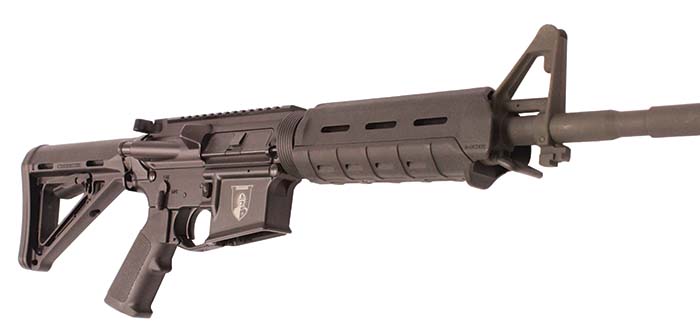
We exercised an additional new method of test firing with the High Standard rifles. Our new test consists of a full beta mag stuffed with mixed ammunition… some new domestic production ammo, some steel cased eastern-bloc ammo, and even some of the dregs from the bottom of the miscellaneous catch-all container at our test range. Some of that ammo may have been picked up off the ground. Some may have spent some time outside on the gravel out in the weather. Sure, we tossed out anything that looked crushed or bent but besides that, dirty ammo, tarnished ammo, and even some rusty ammo was loaded into the 100 round magazine. The firing would commence and continue at the rate of approximately 1 round per second. Of the three rifles subjected to our torture test, we only counted a total of 3 failures. One failure was just bad ignition. Upon reloading and subsequent attempts, that round still refused to fire. So, this was not attributable to the gun. The other failure came in the form of a split shell casing, and a resultant failure to extract. Once again, this was likely caused by bad ammunition. And the third was apparent- a bent cartridge that could not chamber completely: our fault. The role of the fighting carbine is to work – always and forever – and in less than perfect conditions. So our emphasis on reliability illustrates these guns’ rugged and practical potential. Too often we see manufacturers of AR-15s “overthinking” the basic AR. There are brands than apply “national match” accuracy guarantees to a compact lightweight service rifle. There are brands that boast about precision tolerance and fit of a service rifle. To be real, sometimes a gun can be overbuilt for its own good. Match grade can just be another way of suggesting that your rifle might quit when things get inclement. We wholeheartedly subscribe to the idea that these M4 fighting rifles are not precisely assembled to a zero tolerance. They are built up to a role – up to a standard. A 16 inch barreled M4 type carbine is not suited to promise benchrest accuracy. We should accept that the M4 fighting carbine is a tool. It is an implement of aggression and destruction; like a hammer – not a scalpel. It can be a straight shooting hammer, sure – that’s always welcome. But it’s still just a tool. The HSA-15 just works. It performs at the task for which it was built without exception and without excuse.
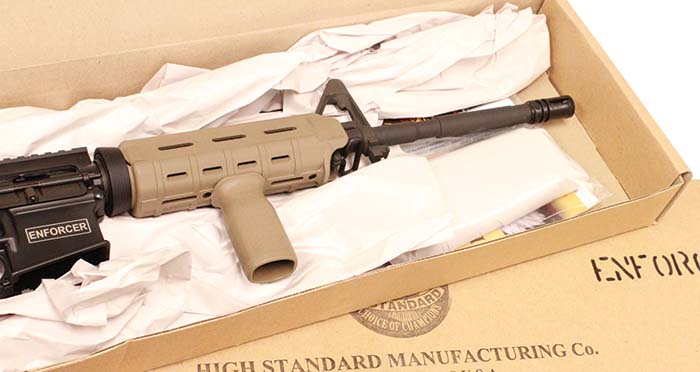
For accuracy’s sake, we tested the rifles from a sandbag, using new, boxed, M193 ball (for the 1-9” twist) and M855 (for the 1-7 twist) made by Federal. The optic chosen for this test was a Leupold Mark 4 M1, 4.5-14 TMR, affixed to our exemplar guns by a pair of new Hawkins Precision Tactical ringmounts. All three guns exceeded the requisite 3 MOA dispersion put forth as minimum military standard. After initial sight-in, the 1-7” Crusader actually maintained better than 2 MOA accuracy – 7 rounds held just at 1 MOA with 3 “flyers” to round out the average to an even 2 inches on our 100 yard target. Accuracy proved adequate for the intend role of these carbines.
The HSA-15 rifles are true AR-15s in the classical sense. No new control surfaces, and no new age materials or coatings. No new ideas, hype or tricks. And best of all they make no inflated or impractical promises of grandeur or superiority. In this new world of tactical excess, High Standard has exercised some rare restraint. They’ve built a basic carbine that works. Just quality rifles built up to a higher standard.
| This article first appeared in Small Arms Review V19N4 (May 2015) |



